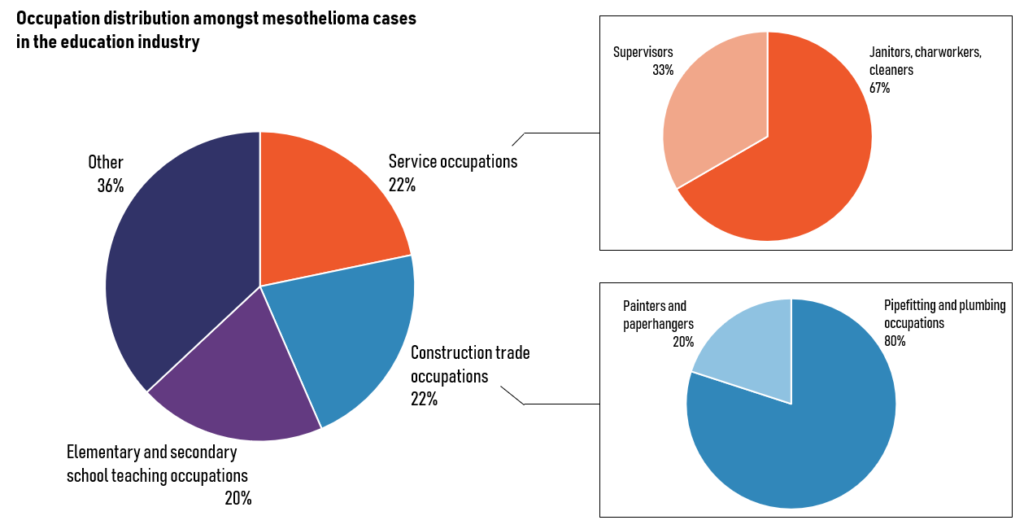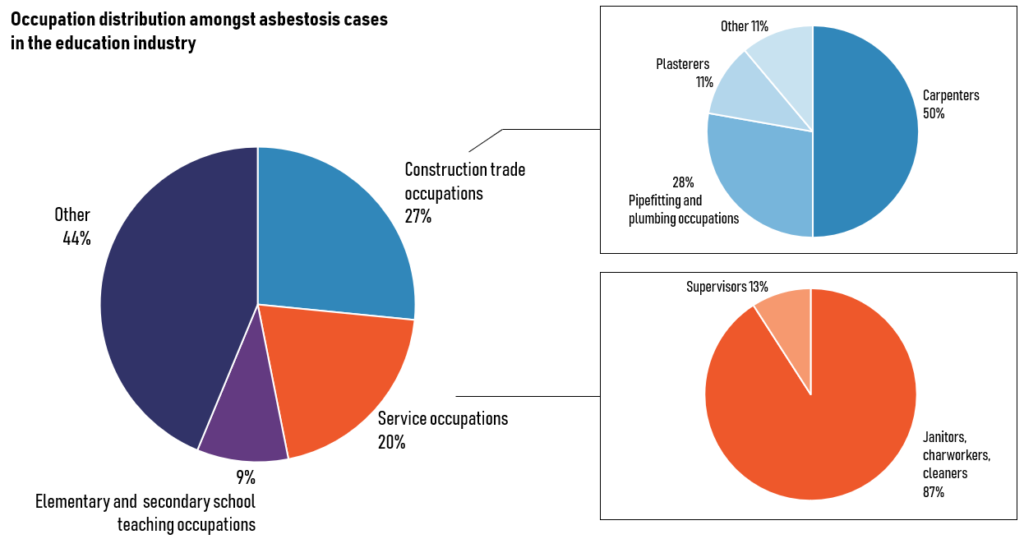Asbestos in Schools: Occupational Risks Among Education Workers
Background
Asbestos was used extensively in the 1930s-1980s in the construction of buildings, including schools, for fireproofing and insulation [1,2]. Due to its widespread use, almost all educational institutions built during this period still contain asbestos. Exposure to asbestos is the only well-established cause of malignant mesothelioma, an aggressive cancer in the lining of the lungs or abdomen, and causes scarring of the lungs leading to asbestosis [3]. Mesothelioma and asbestosis take on average 40 years from first exposure to diagnosis. The time to diagnosis may be faster depending on the intensity and duration of exposure [4]. Asbestos is also an important cause of lung and other cancers.
Workers in the education industry may be exposed to asbestos, which increase their risk of asbestos-related disease, as seen in results from the Occupational Disease Surveillance System (ODSS) [4].
Increased Risks in Education Industry Workers

Findings below show the percent increase for mesothelioma and asbestosis in education industry workers compared to all other workers followed in the ODSS. Risk was highest among workers in universities and colleges, followed by education services and elementary and secondary schools. Surveillance data in the United States has also shown higher reported mesothelioma deaths in elementary and secondary school workers compared to other workers [5].
| Increased risk | ||
| Mesothelioma | Asbestosis | |
| Education and related services | 32% | 57%* |
| Elementary and secondary schools | 13% | 33% |
| Universities and colleges | 132%* | 114%* |
| Education and related services, n.e.c. | 48%* | 129%* |
| *Statistically significant (α=0.05) | ||
Distribution of Cases in Education Workers
Mesothelioma and asbestosis cases in the education industry are further narrowed down into occupation groups in Figure 1. There were a higher number of mesothelioma and asbestosis cases in service and construction trades occupations, primarily made up of janitors and cleaners, pipefitters and plumbers, and carpenters. These workers are often considered high-risk for asbestos exposure in other sectors [4]. While some of the cases were found in teaching occupations, it is important to note that some of those cases had previous employment in sectors such as manufacturing which may impact their risk.


Figure 1. Distribution of mesothelioma and asbestosis cases within the education industry in the ODSS.
Risk Recognition and Prevention
The higher risk found among workers in universities and colleges is an important finding. Various institutions, including the Universities of Toronto and Ottawa, have recently reported finding asbestos in buildings leading to potential occupational exposures [6,7]. Asbestos fibres were found in the dust in the Medical Sciences building at the University of Toronto during construction. The fibres were linked to dust that had escaped from areas in the building where asbestos remediation was taking place [7]. The findings resulted in further review of the University’s asbestos management programs, with recommendations for better oversight, education, and communication of asbestos management planning [7].
Ontario schools that have asbestos are required to have an asbestos management plan, however, these plans may not be well communicated to all workers [8]. A recent study, Awareness of Asbestos Hazards in Schools, Asbestos Management Plans and Training among Ontario School Custodial Workers, was conducted by the Occupational Cancer Research Centre (OCRC). The study found that the majority of custodial workers interacted with ACM either directly (24%) or indirectly (66%), but only 59% are able to recognize it, and only 63% reported using any personal protective equipment [9]. Participants identified concerns with management of existing asbestos in their schools and with training and awareness when working near or with ACM [9].
Although asbestos management plans exist, there is a need for ongoing dissemination and appropriate training of employees. Ontario Regulation 278/05 provides legal requirements and regulations for asbestos management and control in the workplace that all workers should be aware of [10]. Employees should treat all building materials installed before the 1980s as potentially ACM and review the asbestos management plan before doing any ACM disrupting work. Educational institutions are required to maintain and review updated asbestos management plans. Proper management of existing asbestos is imperative to preventing exposure to asbestos.
References
- Canadian Centre for Occupational Health and Safety. (2021). Asbestos – control strategies for workplaces.
- Health Effects Institute. (1991). Asbestos in public and commercial buildings: A literature review and synthesis of current knowledge.
- International Agency for Research on Cancer. IARC monographs on the evaluation of carcinogenic risks to humans. Volume 100C. A review of human carcinogens. Part C: Arsenic, Metals, Fibres and Dusts. Lyon: International Agency for Research on Cancer, 2012.
- DeBono NL, Warden H, Logar-Henderson C, Shakik S, Dakouo M, MacLeod J & Demers PA. Incidence of mesothelioma and asbestosis by occupation in a diverse workforce. American Journal of Industrial Medicine, 2021, 64(6): 476-487
- Tomasallo CD, Christensen KY, Raymond M et al. An occupational legacy, malignant mesothelioma incidence and mortality in Wisconsin. Journal of Occupational and Environmental Medicine, 2018, 60(12):1143-49.
- Casalino M. (2019). The Fulcrum: Asbestos found in two U of O buildings after recent survey.
- University of Toronto Environmental Health & Safety. (2019). Asbestos review panel report.
- ETFO. (2021). Asbestos.
- Occupational Cancer Research Centre. (2019). Awareness of asbestos hazards in schools, asbestos management plans and training among Ontario school custodial workers.
- Ontario. (2020). O. Reg. 278/05: Designated substance – asbestos on construction projects and in buildings and repair operations.
The Occupational Disease Surveillance System (ODSS) Surveillance Alerts provide brief summaries of occupational exposures and disease risks across different industries and occupational groups. The aim of these alerts is to highlight new or emerging issues detected through occupational disease surveillance. At this time the ODSS includes workers from 1983-2014 and follows their health outcomes until 2016. This alert reflects only the diseases currently tracked within the ODSS. The system is updated and expanded on an ongoing basis.
More information about the ODSS including data sources, methods and the most recent results can be found at ODSP-OCRC.ca and OccDiseaseStats.ca.
